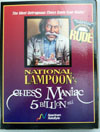The game conference gains momentum.
This morning, the first keynote was “Why Video Games Are Good For You“, a conversation between James Paul Gee PhD, Professor of Learning Sciences, University of Wisconsin – Madison, and Henry Jenkins PhD, Professor of Literature and Comparative Media Studies and Director of Comparative Media Studies Program, Massachusetts Institute of Technology (MIT). Whew!
If I had to choose only one session of this conference to attend, I would have chosen this keynote, and it absolutely lived up to expectations. This dialogue about the benefits of video games and how we could be doing even more to harness the positive learning aspects of them was incredibly inspiring. That hour gave me many new ideas and instilled motivation to explore interesting projects. More amazingly, Sherry (my wife), who generally stays far away from the design side of the business, was inspired enough to rip a page out of my notebook and start taking her own notes. By the end of the session, she had a rough idea of an educational game she wants to develop. I am glad she asked to come along.
For each of the next two sessions, I decided to go to the “paper session”, where three papers on related topics are presented quickly (20 minutes per speaker). The first was “Sound and Game Programming”, which included a interesting presentation on spatial audio by Duncan Rowland of the University of Lincoln (UK), where he discussed the approach used and issues encountered where implementing this technology for Colin McRae Rally while working for Codemasters.
The second paper session was “Games for Learning“, which included a report on a game designed to study gender differences in learning from games, by Carrie Heeter and Brian Winn of Michigan State University, and an interesting case study, presented by Dr. Ricardo Javier Rademacher Mena of Futur-E-Scape, where he talked about his “serious game” to teach physics and his efforts to fund and develop it, first in the academic sector and now as an independent game developer.
Lunch was tasty. I had an interesting discussion about creating a game design and development curriculum to give students a grounding in programming, allowing those with a technical bent to explore more deeply while assuring that those not intending to become engineers still receive an essential understanding of the process. The issues echoed one theme among educators at the conference, whether or not schools should be serving a vocational role with regard to game development. This conversation is not over.
The next session I attended was a panel entitled “Game Intellectual Property Law, Policy and Issues“, which consisted of presentations by two practicing attorneys, one lawyer-turned-developer, and a independent developer with an opinion. Unlike similarly titled sessions at other conferences, this one did not waste time with the basics of copyright, trademarks, and patents, but jumped right into the tricky issues of IP, including the question of who really owns virtual game assets and the significant problem of process patents on games. It was a good and well-attended session, though I wish that the pure developer had stood up and more clearly stated that process patents on game mechanics are evil.
I remained in the same room for the next panel, the highly anticipated, “Game Content, Ratings, Censorship and the First Amendment“, which was scheduled through two sessions, with no break, and still ran long. This was an honest debate on the issues, as opposed to the worthless political exercise that was “debate” on the anti-game legislation (now law) in Michigan. Having testified before the Michigan Senate Judiciary Committee back in May, I experienced first hand exactly how little the legislators wanted to learn about the actual issues, and how most of this was a cynical political game where the actual issue was secondary (at best). Here there was room for real intellectual exchange of ideas, not that anybody changed their mind on the subject.
Henry Jenkins of MIT began the panel with the difficult task, as he put it, of refuting a position that had not been stated yet. He is a strong advocate of the First Amendment as applied to games, but he is unhappy with Rockstar for deliberately pushing the envelope into games like the upcoming Bully, which unfairly puts the whole game industry on the defensive. Dr. Clay Calvert of Penn State is also a strong advocate, but he noticeably ruffled some feathers on the panel and in the audience by suggesting that video game research is done intending to find correlations between games and violence and studies that do not show any connection are never published. Jason Della Rocca of the IGDA gave a strong presentation with several compelling facts, including the FBI statistics that show 2003 had the lowest rate of youth violence in recorded history, despite the massive growth in video games. This fact, which seems to immediately trump opposing arguments, continues to go unaddressed.
On the other side of the fence, Kevin Saunders of MSU said basically the same things he said when he testified ahead of me back in May, and I find unconvincing his argument that despite a lack of proof and an 0-3 record on past legislation, all being declared unconstitutional, we should keep legislating and litigating (at public expense) until one slips through, especially given that his books give him a vested interest in stirring the pot of controversy. Craig A. Anderson of Iowa State claims that he simply does research and does not advocate any position, but his conclusions seem quite biased and I, frankly, think that he is deluding himself with such a statement. John Lazet, who was integrally involved in the anti-game legislation here, showed photos of a single traffic accident intended to be dramatic and evocative, but admits that video games did not cause it to happen.
The panel was definitely interesting and, if anything, my personal views were reinforced. There is certainly a need for us, as an industry, to be more responsible. It is also high time for legislators to recognize that games are a medium for artistic expression. These attempts to blame video games for all of society’s ills and demonize developers in McCarthy fashion need to cease so we can concentrate on the real issue of poverty, which has a strong correlation with youth violence. The media must stop sensationalizing the issue, which only sells more copies of the titles in question, encouraging even more immature game designs. Above all, parents need to take responsibility, and when certain games are too violent, STOP BUYING THEM FOR YOUR CHILDREN!
After the session, there was a wine and cheese party, at which I heard the quote, “Wow! It really is a wine and cheese party.” During this time, the ballroom was filled with games submitted for judging in the areas of future game development, future game impacts and applications, and future game talent, the three themes of the conference. I was asked to be a judge (of six or seven) so, instead of networking and schmoozing as usual, I looked at all of the games and selected
my two choices in each category. All I can say is that there is some impressive work being done in innovation, learning, and student game development.
Finally, we were on our own for dinner, followed by the Birds of a Feather gatherings. Many of us gathered at the intended location for the “Gender & Diversity” and “Indie Games” BoFs, the latter being the one that most interested me. After a half hour with no sign of our hosts, we all decided to head for Harper’s Brewpub where GarageGames was hosting the “Torque Users” BoF and buying the first round. After a while, Greg Costikyan of Manifesto Games arrived with the explanation that the speakers’ dinner had run late. There was lots of discussion on all three topics, with some drinking and munching, and a good time was had by all.







